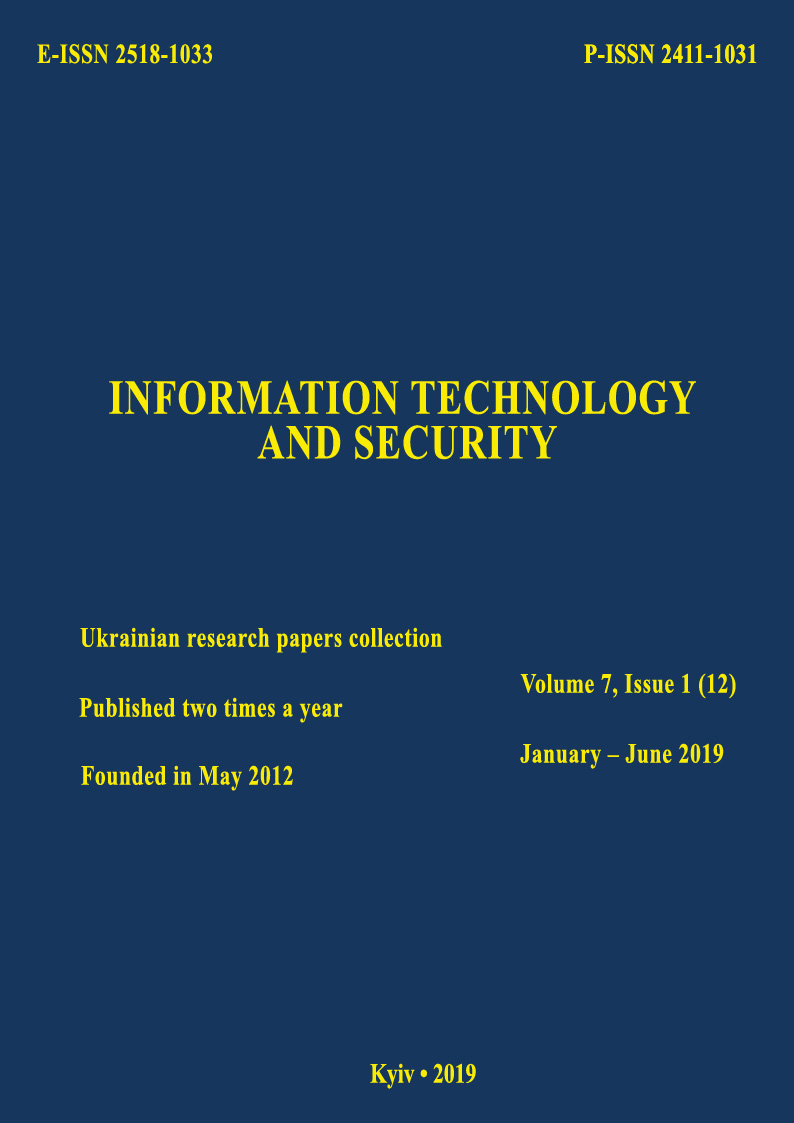Topologies of schemes of active dynamic compounds of objects
DOI:
https://doi.org/10.20535/2411-1031.2019.7.1.184324Keywords:
Topologies schemes of compounds, integrated objects, compounds of objects, combination schemes, feedback schemes, schemes with controllersAbstract
The research results of methods for constructing schematics of objects compounds used to create software with architecture based on integral objects are presents in the paper. The basis for determining the main topologies of the compounds schemes is the major elements of compounds classification, including the types of objects of compounds, types of connections and types of calculations that the compounds implements. The objects from which are built compounds were divided into four types: data, functions, switches, and activators. Data objects are represented by variable and constant objects that store data. Function objects perform transformations of input data into output results, implementing a specific function or composition of functions. Switch objects perform the function of dynamic connections control within fixed connections in the scheme and are represented by classes of interrupters, switches, and selective switches. Activator objects are intended for constructing schemes that require multiple or sequential activations of objects and are represented by classes of cyclic and step-by-step activators. Types of connections between objects in compounds are divided into three types: active or passive, fixed or switched, forward or backward. Activity or passivity of connections is determined by the output connector’s type, involved in a particular connection. The fixity or commutation of connections is determined by the absence or presence of switches in the compound scheme. Feedback allows transferring object data from its output to its input or to the input of previous objects or to use recursion. The calculations types that implement by compounds are divided into three types: functional, iterative, and step-by-step calculations. Functional calculations take place when the states of objects are not used. Iterative calculations require the reactivation of the same objects in the process of calculating the result, and step-by-step schemes sequentially activate various objects of the scheme in a defined order. Based on the developed classification of the compounds scheme’s elements, three types of basic topologies were defined: combinational schemes, feedback schemes and schemes with a controller. Combination schemes implement functional calculations. Feedback schemes can implement both functional and iterative (recursive) calculations. Schemes with a controller used for activators to implement iterative and step-by-step calculations. By combining basic topologies, complex schemas can be obtained
References
A. Doroshenko et al., “Formal and adaptive methods and tools of parallel programming”, Problems in programming, no. 3, pp. 19-30, 2017.
E. Lavrishcheva, “Paradigms of assembling kind programming in software engineering”, in Proc. International conf. UkrPROG, Kyiv, 2014, pp. 76-92.
P. Andon, O. Slabospitska, “Assembling kind programming of component and service-oriented applied software systems”, Problems in programming, no. 3, pp. 31-51, 2017.
R. Kuhn, B. Hanafee, and J. Allen, Reactive Design Patterns, Saint-Petersburg, Russia, 2018.
V. Sokolov, “Architecture of software based on integrated objects”, Information Technology and Security, vol.5, no. 2, pp. 51-59, July-December 2017. doi: 10.20535/2411-1031.2017.5.1.120559.
V. Sokolov, “Structural analysis of the compounds of integral objects”, Information Technology and Security, vol. 6, no. 2, pp. 68-78, July-December 2018. doi: 10.20535/2411-1031.2018.6.2.153491.
V. Kolesnik, “DS-theory. Presentation of canonical algorithm by means of algorithmic language”, Problems in programming, no. 1, pp. 3-18, 2015.
M. D. Shah, and S. Z. Guyer, “An Interactive Microarray Call-Graph Visualization”, in Proc. IEEE Working Conference on Software Visualization, Raleigh, USA, 2016, pp.86-90, doi: 10.1109/VISSOFT.2016.14.
M. Alnabhan, A. Hammouri, M. Hammad, M. Atoum, and O. Al-Thnebat, “2D visualization for object-oriented software systems”, in Proc. International Conference on Intelligent Systems and Computer Vision (ISCV), Fez, Morocco, 2018, pp. 1-6. doi: 10.1109/ISACV.2018.8354085.
Downloads
Published
How to Cite
Issue
Section
License
Copyright (c) 2020 Collection "Information technology and security"

This work is licensed under a Creative Commons Attribution 4.0 International License.
The authors that are published in this collection, agree to the following terms:
- The authors reserve the right to authorship of their work and pass the collection right of first publication this work is licensed under the Creative Commons Attribution License, which allows others to freely distribute the published work with the obligatory reference to the authors of the original work and the first publication of the work in this collection.
- The authors have the right to conclude an agreement on exclusive distribution of the work in the form in which it was published this anthology (for example, to place the work in a digital repository institution or to publish in the structure of the monograph), provided that references to the first publication of the work in this collection.
- Policy of the journal allows and encourages the placement of authors on the Internet (for example, in storage facilities or on personal web sites) the manuscript of the work, prior to the submission of the manuscript to the editor, and during its editorial processing, as it contributes to productive scientific discussion and positive effect on the efficiency and dynamics of citations of published work (see The Effect of Open Access).

